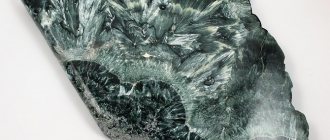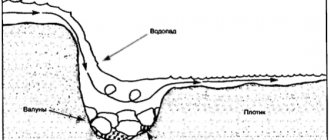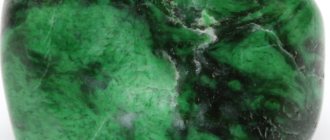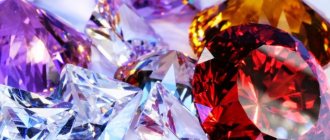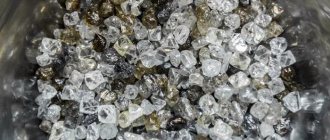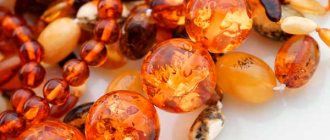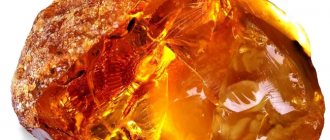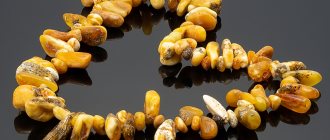What is amber and what are its properties?
Amber is found in places where many coniferous trees previously grew, and this is not surprising, because amber is nothing more than their fossilized resin.
However, in this precious world there are exceptions - blue Dominican amber, which was formed from larch resin. On different continents and even in different nationalities, the name of the stone was different, but the word “amber” itself was presumably borrowed from the Lithuanian language. Poets also attribute many lyrical comparisons to the stone, for example, “tears of the sea” or “gift of the sun.” The properties of amber are not quite typical for a semi-precious mineral.
First of all, it lacks the ability to form crystals and is essentially a framework amorphous polymer. It is easy to process and polish, for which it is very loved by craftsmen who work with minerals. It does not refract light, as many other semi-precious stones do, and does not change its color when light hits it from a different angle. What is noteworthy is that this mineral is quite flammable; a flame of a match is enough for it to ignite and begin to release a pleasant aroma. When rubbed, amber becomes electrified, and when exposed to air it reacts with oxygen - it oxidizes, becoming less bright over time and becoming friable.
Origin of amber
Even ancient scientists came to the conclusion that amber is of plant origin. The Roman scientists Pliny and Tacitus pointed out the specific plant smell when rubbing the mineral, as well as the fact that insects and small animals were often found in the stone. Tacitus believed that amber was the frozen juice of plants that fell into the sea.
The 16th century German mineralogist Agricola believed that the mineral was of inorganic origin.
In the 18th century, the theory of plant origin was confirmed by the Swede Linnaeus, a famous botanist. A little later, Russian scientist Mikhail Lomonosov came to the same conclusion.
Scientists have proven that the amber stone that is now mined was formed more than 40 million years ago from amber-bearing pines, that is, it is of plant origin. At that time they grew in North America, Greenland, and Eurasia. Under the influence of climatic conditions, resin was released, which petrified and fell over the years. The coming sea carried her away from the shores.
Varieties of amber
To classify amber, experts pay attention to its molecular structure and degree of transparency. Often in stones you can find frozen particles of plants, insects and other organisms; such stones with reminders of the past are called inclusions and they are of great value to paleontologists. In general, a distinction is made between fossil and semi-fossil amber.
The stone that belongs to fossils is also called succinite. This species accounts for up to 98% of all Baltic amber. An important feature of the classification is the degree of fragility, which is determined using a special tool - a microhardness tester in grams. Brittle resins - gedanite, have a fragility in the range of 20-50 g, viscous - succinite, more than 200 g. The fossil is also characterized by the degree of its transparency, which is formed from the number of voids present in it. On this basis, amber is classified as follows:
- foamy – opaque with cavities up to several mm;
- bone - opaque, ivory in color, density 900,000 sq.mm;
- bastard – opaque with a density of 2500 sq. mm;
- cloudy – translucent, density 600 sq.mm;
- transparent - without voids (the highest quality stone).
The color of amber can be not only orange-yellow; chemical compounds trapped inside the resin can give the finished fossil completely different colors of the spectrum.
What is amber
Even ancient naturalists guessed about the plant origin of amber. Amber cannot be called a mineral. According to the IMA (International Mineralogical Association) classification, amber belongs to fossil resins. From a chemical point of view, amber is an amorphous polymer with the formula C10H16O+(H2S). The density is slightly higher than that of water: 1.07 - 1.09 and a maximum of 1.3 g/cm³. Hardness on the Mohs scale 2 -2.5.
The color of amber is very diverse: from almost white to green and even blue with all sorts of shades. The reason for the diversity is the impurities of foreign substances in the resin composition. In ultraviolet light, amber glows bluish-white and yellow-green. Like other biogenic formations, amber gradually ages, that is, it oxidizes in air, which leads to fragility and darkening of color.
Amber does not like high temperatures and is destroyed already at 200 °C, forming amber oil and amber resin. Placed in fire, it ignites easily. Soluble in alcohol, ether and chloroform.
There are different ways to classify amber. Important features are the macromolecular structure of the resin and the degree of transparency. It is known that amber contains remains of ancient flora and fauna, inclusions. If their size exceeds 10 mm, such a stone is considered precious.
As we have already said, amber is a fossil resin. And therefore, in order to find out how resin turned into stone, we will go into the distant past.
How is amber mined?
Many people are interested in how amber is mined, but what is noteworthy is that although the extraction of the mineral has been going on for many years, the technical means for developing deposits have not changed over a long period. Only 19th century. During the period of technology development, new methods and equipment appeared that made it possible to significantly increase the volume of extracted raw materials. Along with the improvement of the process, it was possible to reduce the harm from mining to the environment.
Water extraction
Amber can be mined in water or on land. If the stone is mined on the water, then this can be done by hand picking after high tide, loosening the soil under water with long poles and industrially lifting the soil from the bottom of the sea. Collecting stone after high tide is one of the most ancient ways of extracting amber, but such stones are usually small in size and have a dull and dark color. Prospectors can either lift stones on the shore, which requires efficiency, or catch amber brought in by the tide, using special equipment.
In good weather conditions - bright sunshine and calm water - you can also see the stones lying on the bottom. Then the miners loosen the soil underwater with long poles and catch the minerals that have risen to the surface. Mining is also carried out on an industrial scale, when soil supposedly rich in this mineral is lifted from the bottom, sending it further for sifting, sorting and enrichment. However, this method is in low demand due to its high cost and significant damage to nature.
Land mining
To extract amber using this method, a mine or quarry method is used. However, mine mining is currently practically not used due to its technical disadvantage, but open-pit mining is still in demand. It consists of several stages:
- exploration work at a depth of 5-60 m;
- removal of waste rock using special equipment;
- removal of fertile soil;
- processing the rock to identify minerals;
- cleaning and sorting of stone.
This process is also not cheap, so the natural gems obtained using it are comparable in cost.
The largest amber deposit in the world
Now that technologies for recognizing and extracting sparkling gems are constantly improving, people are finding more and more varieties of hardened resin . If previously only those collected on the Baltic coast were considered real cabochons, now this category includes any nuggets older than 1 million years (younger ones are called copals and, because of their softness, are used mainly for industrial purposes). Thanks to this, unusual colors and textures of precious stones were discovered, and inclusions from them helped to learn a lot about the flora, fauna and even climate of previous eras.
Researchers have data on over 200 deposits, and here are some of the most famous deposits:
- The Saxon-Anthal quarry (Germany) is located near the city of Bitterfeld. Amber was formed from it 22 million years BC. e. and does not have a weathering crust. From 1975 to 1990, approximately 400 tons of gems were mined, and then the mine was flooded;
- Cabochons from the Baltic region have already been mentioned above. In modern conditions, these include hardened resin from Norway, Denmark, Sweden, the Frisian Islands, Estonia, Latvia, Lithuania and Poland. Gemstones from these regions are very beautiful and durable, as they arose from the pure resin of the Pinus Succinifera pine tree between 100 and 25 million years ago. There are also deposits in the Czech Republic, Slovakia, France and Switzerland, but there is so little amber in them that its development will not pay off;
- They also successfully search for solar gems in England, in the coastal counties of Kent, Norfolk, Suffolk and Essex. Most likely, the cabochons were brought there by the North Sea current;
- gemstones from Sicily (simetites) are famous for their rich blue, olive, reddish-violet hues. They were formed from the resin of tropical angiosperms, so such gems have a low content of succinic acid, but a lot of iron;
Amber mining
- The Romanian (Carpathian) deposit gives people magnificent rumenites, also known as black amber. But in the light it is clear that in reality these cabochons shimmer with deep crimson, indigo, and brown tones. This color is provided by impurities of sulfur and iron;
- African gemstones are mined in Tanzania and Lebanon. The raw material for them was the gum of agathis trees that grew in the Lower Cretaceous period (135-100.5 million years BC). The gems contain inclusions from those times - for example, an Archeopteryx feather;
- Japanese cabochons lie next to layers of brown coal. Their number is small, but this is compensated by an interesting color - striped, like agate or feldspar. The age of the frozen resin is from 120 to 85 million years;
- where to look for amber in Asia? It is found in eastern China, off the coast of Indonesia and on the island of Kalimantan (Borneo), and the largest deposit is in Myanmar (Burma). Burmites are one of the oldest gemstones (105-97 million years old), thanks to which they contain such extraordinary inclusions as the feathered tail of a dinosaur, the ancestor of modern lizards and the chick of Enantiornis. But now these reserves are almost gone - prospectors extract only 10-500 kg of gems per year;
- deposits on the island of Haiti, where the Dominican Republic and the US state of the same name are located, are the source of “opal” cabochons, shimmering with bluish, emerald, and lilac highlights. And under the influence of ultraviolet light, amber begins to emit a phosphorescent glow! Precious stones appeared from the resin of the fossil tree Hymenaea protera, which grew 40 million years ago on the slopes of the Cordillera, so clusters of gems are located at an altitude of 500 m - 1.2 km in quickly crumbling sandstone;
On the shores of the Baltic Sea
- Where does amber come from in Canada? Deposits of the so-called Cedarite ambrite is found near the cities of Alberta, Grassy Lake and Medicine Hat, and near lakes Cedar and Manitoba there are secondary deposits, that is, the gemstones were brought there by the waves of ancient seas. Such nuggets are very important for science, because they often contain unique inclusions - ants, mites, pollen and spores of prehistoric plants;
- in Mexico, hardened resin was recently discovered in the state of Chiapas;
- cabochons called retinites are even found in southeast and southwest Greenland. Their age is about 100 million years, and butterflies, ants, mosquitoes and tropical flower petals enclosed inside amber indicate that dense forests once grew in place of the ice fields;
- In New Zealand, both true gems and copals are mined from the resin of kauri and agathis trees (the latter are most often used for making varnish).
Process description
Approximately about 50 million years ago, even before the appearance of man on Earth, there was dry land in the territory of what is now Sweden and part of the Baltic. And this is an important circumstance for understanding the processes of the origin of amber in nature.
The first step in the formation of a mineral is the release of resin from coniferous trees. This was most likely due to a sharp warming of the climate. Pines were highly sensitive to climate change. When hurricanes and thunderstorms began, pine trees released a special resin-resin.
It worked better than an antibiotic: the resin quickly dried out, forming a hard, smooth crust at the site of the damage.
The thick and very sticky liquid led to the formation of nodules, drops, and clots on the trunks, which ended up on the ground under the weight of their own weight. The bulk of the resin flowed out of the pine during the spring windbreaks. But rodents, who did not spare the pines, led to injury to the trees, and thickly leaking resin was used to “heal” the wounds.
The process of resin release could end and begin again, which led to multi-layered accumulations of resin . Insects could land on the resin; they would stick to the sticky liquid and remain there. Forever.
Burial of resin
This can be called the second stage of amber formation. This process is caused by physicochemical changes. It was very important in what specific conditions the resin would end up. If the soil was dry, then oxygen took an active part in the transformation of oleoresin: its stability increased and its hardness increased.
But the wetlands did not help this, because the resin there remained fragile.
Next, erosion, transfer and deposition of resin into the water occurs. The conditions that could become necessary for the formation of amber are associated with the hydrodynamics and geochemistry of the basin.
In order for amber to form in nature, special waters are needed - silt, with oxygen, rich in potassium. When these waters come into contact with the resin, succinic acid and other esters of this acid appear in it. At the end of these complex processes, not only amber itself is formed, but also glauconite. And the definition of the latter led researchers to think about weakly alkaline and weakly reducing environments.
These transformations led to the fact that the resin became significantly denser, became not as soluble as initially, and its viscosity and melting temperature increased. The small molecules in the resin became one macromolecule.
This is how amber, which is a high-molecular compound, appeared.
The climate necessary for its formation
The climate in northern Europe, where amber was formed millions of years ago, was similar to the current climatic conditions in southern Europe and the subtropics. The average annual temperature did not fall below plus 18 degrees.
What else can be said about the climate in which amber is formed:
- not very high illumination of the forest, little light reached the lower branches due to the upper closed crown;
- vegetation prevented ultraviolet radiation from reaching the ground;
- forest soils were sandy, covered with a layer of soft soil litter;
- the air is almost oversaturated with water vapor that rose from the damp ground.
In this climate, everything was conducive to the development of lush vegetation. There is even such a concept - “amber forest” . This is a complex plant community that is difficult to characterize even with very detailed descriptions. Some scientists believe there were up to twenty species of pine trees alone.
After the climate became much harsher, the “amber forests” disappeared. Most of the territory they occupied went into the ocean. Only amber, a resin that incredibly fossilized, remained a witness of prehistoric times. Amber “remembers” the planet even before the appearance of man.
It turns out that the stone became an artifact, and also opened the door to a very ancient past for modern scientists, helping to restore the picture of the “amber forests” with their unique flora and fauna.
Physical properties of the stone
The hardness and melting point of amber is higher than that of the best varieties of copal. The honey yellow mineral has been proven to be soluble in terpene and organic hydrocarbons. In its natural occurrence, amber can be found in the form of fragments of various sizes, which resemble in shape the resinous secretions of coniferous trees.
The density of amber is almost equal to the density of sea water: in salt water the mineral floats, and in fresh water it sinks. This circumstance explains the stability and indelibility of the stone, which survives repeated transfers, washing, reburial, and all this for tens of millions of years.
There are other physical properties of the mineral.
- Amber melts on a candle flame and begins to boil at a temperature of 250-300 degrees. Heating causes the mineral to smolder and burn with a smoky flame. The smell will be pleasant, resinous. By the way, this is the best way to distinguish genuine amber from a fake - heating the fake, of course, will not bring any resinous aroma.
- When rubbed, amber becomes electrified, attracts small objects, and charges with static electricity. And another interesting historical fact is connected with this: the ancient philosopher Thales of Miletus discovered this property of amber. Researchers picked up the philosopher’s discovery, saw blue sparks when rubbing a stone with wool, and called these sparks electrons. And electron, by the way, is the Greek name for amber.
- If you ask what the color of amber is, the answer will be clear - yellow . But experts have counted about two hundred color shades, contained in a fairly wide range of colors. Under the influence of the sun, amber will glow. The luster of the stone is glassy, resinous, the surface is conchoidal and uneven.
- The air bubbles observed in amber contain about 30% oxygen.
In one amber drop there is evidence of events not just many years ago, many millions of years ago.
Bugs, mosquitoes, butterflies, lizards, leaves, flowers, pine cones and other organic remains preserved in amber are what make the mineral so unique and valuable to science. It turns out that this stone is not just beautiful, its formation is more interesting than its decorative aspects.
Where does it lie?
So where is amber mined in Russia? The most famous deposits of this stone in our country are strata placers located on the shores of the Baltic Sea, about 40 km from Kaliningrad. Amber from these deposits has been mined since ancient times. But there are still thousands of tons of it here. At the moment, in this area near the village of Yantarny there are a total of three deposits, one of which is mothballed. This particular area is today the largest and richest placer not only in Russia, but throughout the world.
Of course, there are other areas of amber deposits in the Russian Federation. There are small deposits of this stone in our country, for example, in the Urals, Siberia and Sakhalin. You can find amber in some other places in Russia. The peculiarity of solar gem deposits is, first of all, that they are located along a special grid consisting of straight and broken lines. At the same time, the richest vein runs from the Jutland Peninsula through the Baltic states, through Finland and further towards the Kola Peninsula. Here, across the Arctic Ocean, it continues to the “Amber Crown” of the planet.
The largest deposits are located in our country, of course, in the Kaliningrad region. Where amber is mined in the Russian Federation in the Baltic and we will look at it in detail below in the article. In addition to the three in Kaliningrad, in our country there are only two more more or less large deposits of this gem. One of them is located in the Khatanga depression (North Siberian), the second in the Far East. However, there is no industrial development of stone in these areas. The fact is that there are no large pieces of amber here.
Where to find amber in Russia
Deposits of the solar mineral are located on the coast of the Baltic Sea; this body of water washes the territory of Russia in the Kaliningrad region. Many are trying to obtain this stone illegally. In addition, almost every tourist wants to take with them a “piece of sun” found on the shore.
For those who want to feel like a prospector, special excursions are organized at the Palmnikenskoye plant, where you can “get” a souvenir in improvised deposits.
There is a high probability of finding “pieces of sun” on the coasts of Svetlogorsk, Zelenogradsk, Pionersky, and the village of Primorye.
While vacationing on the Baltic coast, you can inexpensively purchase legally mined minerals or products made from them in any store. This is how they bring blue or white amber with them to Moscow or another city, which reminds them of the sea.
Blue amber
How to find amber on the seashore
- Collecting amber, including on the Baltic Sea coast, is prohibited by law, so it is better not to do this, but to calmly contemplate the seascapes, as well as the sights of the Baltic.
- For sport, you can try to find minerals, but do not take them with you, but leave them in place so as not to break the Law.
- It is best to look for amber on the seashore after a storm: small minerals are washed ashore along with debris, the remains of vertebrates, and black algae.
- Among this unsightly accumulation you can see pieces of frozen resin shining in the sun. To do this, you may have to arm yourself with some kind of stick or rake out the garbage with your hands.
- Local prospectors take nets with them, go into the water and shine a flashlight on the accumulation of black algae: if there is amber among them, when an ultraviolet ray is directed at it, the mineral will glow green.
- When using a flashlight, gems are better visible after sunset.
- After a storm, the police sometimes appear on the shore and check with people walking along the beach to see if they have a large amount of amber.
Amber on the seashore
Water tube mining
- Experienced prospectors extract amber in so-called water tubes, which are located on the shore or in the Baltic Sea itself.
- Water tubes are small hollows flooded with water.
- If there are gems in such mines, then the water usually contains blue clay.
- Minerals in such pipes lie at a depth of about 5 meters.
Amber in the forest and near the river
- Amber jewelry is sometimes found in the forests of the Kaliningrad region.
- Prospectors track passages dug by moles.
- If there is blue clay in the soil they bring to the surface, it probably contains solar minerals. To search for stones in such a place, excavations are carried out.
- To find gems along rivers, you need to study the surface of the earth after heavy rains. It is best to search in early spring, when there is no vegetation.
- When going in search of amber, it is worth remembering: collecting and storing such stones is punishable.
Raw amber necklace
Interesting facts from the history of Russian amber
- The first finds in Russia date back to the Novgorod excavations and date back to the 10th century. Even then, craftsmen used techniques to change the color of a gem - “lightening” and “annealing”.
- Until the 18th century, the origin of the stone from the resin of ancient coniferous trees was hypothetical. The scientific substantiation of this fact was made by M. Lomonosov in his works “The First Foundations of Mining Science” and “The Word on the Birth of Metals from Earth Shaking.”
- Amber in Russia is represented by several varieties, but the predominant part is succinite, containing a large amount of succinic acid.
- The most mysterious phenomenon of the twentieth century associated with Russian amber is the disappearance of the Amber Room. The unique masterpiece, stolen by the Germans during the Great Patriotic War, has not yet been discovered as a single exhibit.
- There are repositories and exhibitions of the gem in Mexico, the Dominican Republic, Poland, Lithuania and Latvia. But the most unique and full-scale in this series can be called the Kaliningrad Amber Museum, located in the Don Tower (28 halls, 11,000 exhibits).
- Inclusions (foreign inclusions in the structure of the stone) in Baltic succinite are distinguished by their fauna, these are mainly insects.
- The largest collection of amber with inclusions is also located on Kaliningrad soil, in the Museum of the World Ocean.
As you can see, the places where amber can be found are concentrated locally in Russia. The riches of the Baltic waters and beach areas are priceless in this regard.
As well as masterpieces given to the world by human labor and natural solar gems.
Types of deposits
All amber deposits are divided into two large groups: primary (root) and secondary (placers). In our country, the first type of sediments includes the Ural, North Siberian and Far Eastern. Deposits of this type are always associated with coal seams. Amber in such rocks occurs in the form of inclusions. Deposits of this type are located where coniferous forests grew in ancient times.
Placer deposits can be river or marine. They are usually located at some distance from the indigenous ones. Amber accumulates here, being brought by water, glaciers or earthen slides. In Russia, the city where amber is mined is Kaliningrad. The deposits located here are of the alluvial type.
Such secondary areas are in turn classified into:
- alluvial;
- deltaic;
- coastal-marine;
- marine;
- glacial.
A special feature of amber is, among other things, its low density. That is why such gems are easily transported by water. Alluvial deposits are those where amber, moving with the flow, was once stopped by some obstacles, for example, boulders or wood jams.
Delta deposits of this gem are found on the coast in shallows and estuaries. Coastal-marine deposits are formed due to the erosion by waves of sediments located below sea level.
Sea placers once arose at the bottom of deep bays, protected from the winds. The amber-bearing rock in these places has a heavenly hue and is called “blue earth” accordingly. Glacial deposits arise in areas of glaciation due to the destruction of previously formed deposits by moving frozen masses.
Processing and use of amber
The main area of application of amber is, of course, the creation of jewelry. But the stone is also used to decorate household items and create large shapes. One of the most famous works is the now lost Amber Room.
Before World War II, amber processing was carried out mainly by hand. After the war, technologies were improved at the Kaliningrad plant. For example, round beads begin to be made by rolling on drums. Then technologies of melting, heating, and creating pressed amber were adopted.
Using a gem
Kaliningrad amber is the main raw material for the manufacture of jewelry in many factories around the world. Amazing products are created from gems of Baltic origin: earrings, beads, necklaces, pendants, rings, souvenirs. Paintings made from solar gems, icons and rosaries are also popular. All these products can be purchased in the Yantar Rossii online store. The online showcase of the site is replete with a wide assortment of more than 1000 jewelry. Many of them are handmade by talented craftsmen, so they will certainly arouse interest among lovers of exclusive and unique products made of amber stone.
What is the Palmnikensky section
So, next, let's look at how amber is mined in Kaliningrad and where exactly the development is carried out. The total area of deposits of this gem in the Baltic Sea in Russia is more than 300 km2. The largest not only in the Russian Federation, but also in the world at the moment is the Palmnikenskoye field located near the village of Yantarny. About 70% of all amber deposits on the planet are concentrated here.
The Palmniken deposit began to be developed industrially in the century before last - in 1872. In all subsequent years, up to 300-800 thousand tons of amber were mined in these places per year. At the moment, the Palmnikenskoye field is mothballed. Development today is carried out at two adjacent sites: Primorsky and Plyazhevoy.
Where is amber mined in Russia: Primorskoe deposit
Geologists classify amber deposits in the Kaliningrad region as a unique mineral object. The stone here lies very close to the surface. It is mined from a depth of 8-50 m. Near coastal villages, amber in this place is often found simply on the beaches. The Primorskoe deposit in the Kaliningrad region, according to scientists, already existed during the Paleolithic. This is evidenced by pieces of amber found at sites of primitive man.
The amber-bearing “blue earth” in this place lies at a depth of 2-6 m. The content of gems in it ranges from 587 to 1464 g/m.
Primorsko-Palmnikenskoye field
It is located on the western coast of the Zemland Peninsula, 40 km northwest of Kaliningrad. Where there is amber is indicated by deposits of the so-called. “blue earth” - greenish-gray clayey sands with an admixture of quartz and glauconite. They lie at a depth of 40-100 m, and the layer thickness is 0.5-15 m. These soils were covered by the sea during the Oligocene (33.9-23.03 years BC) and Miocene (23.03-5. 3 million years BC), but the cabochons hiding there are much older - their age exceeds 50 million years!
Among Kaliningrad gems there is not only valuable succinite. Up to 2% of production comes from gedanite - “rotten stone”, cloudy and brittle. Kaliningrad amber can be round (this means that in ancient times it was rolled by tidal waves) or clawed - with protruding corners and edges. Its size also varies - from tiny grains with a diameter of 5 mm to kilogram giants. And the most massive specimen weighing 12 kg was found in the 19th century.
According to rough estimates, 70-90% of the world's amber is concentrated in this deposit. In 1 m3 of parent rock there is from 0.6 to 2 kg of hardened resin, and almost the same amount of precious stones on the sea shelf that is adjacent to this area. Even though one of the quarries is mothballed, and prospectors annually extract up to 350 tons of cabochons, the reserves will last for a long time.
Amber mining on the ocean shore
Beach area
This quarry is also one of the answers to the question of where amber is mined in Russia. At this deposit, gems are most often obtained from a depth of 8-10 m. The average amber content in this case is 1588-2471 g/m3. This placer is located under the bottom of the Baltic Sea and on the adjacent beach. On the shore it also lies below sea level. Along the Baltic, the field extends for approximately 750 m. Its width is 150-200 m.
The Plyazhevoye deposit is composed of rocks of the Neogene, Paleogene and Quaternary periods. Amber here, as in the Primorsky site, is mined from “blue earth”. Gems of marine origin in Paleogene rocks occur in this place.
Cave amber stone
This species is found during excavations of ancient caves that served as habitats for ancient people. And in ancient burials various amber products are found - amulets, knives, bracelets, and so on.
Caribbean amber
Insects “walled up” in stone are often found in it. This is a very ancient deposit. Caribbean stone is tens of millions of years old. Everyone knows the green Caribbean amber stone.
American deposits
Dominican Republic
Light yellow stone is common here, and very rare blue and green species are also mined. Extraction is carried out in mines, which is not typical for modern times. The purest color of green amber comes from the La Cordillera mine.
The amber deposit near the village of Sabana supplies the market with a cheap stone, the negative feature of which is its excessive softness. All types of Dominican sunstone are included in the American amber province.
The Dominican stone is one step inferior to the Baltic - it is the second highest quality amber in the world. But it is distinguished by its transparency and frequent inclusions (fossil insects or plants). It is only 40 million years old, unlike Lebanese amber. These stones are already 135 million years old.
Mexico
Mexican amber is mined in the south of the country. It is dark in color, but sometimes there are small clusters of valuable blue stones. Nicaragua owns similar species.
The common name for stones mined in the Caribbean Sea is Caribbean amber.
Amber mining in ancient times
In ancient times, amber was mined in the same way as individual tourists do now - they looked for it on the coast and collected it by hand. Thus, according to scientists, about 60 tons of the mineral were mined.
By the 14th century the technology had changed slightly. They began to make special nets that were used to extract amber stone from the sea. It was found in algae, entangled in leaves.
Then the technology became more complex. Using various tools, miners began to harrow the seabed, as a result of which the golden stone was freed from silt and floated to the surface, since it is lighter than water. The amber catcher got it from there.
In the 17th century, attempts were made to extract the mineral from cliffs near the sea. This was successful where the sea left the mainland over the years, leaving deposits of wonderful resin on land. Attempts were made to extract the mineral from mines, but low profitability caused the mines to be abandoned.
Industrial extraction of amber
How is amber mined nowadays? The process of extracting amber stone is very labor-intensive. First, the top layer of the deposit's soil is removed with an excavator bucket. Then the resulting soil enters special separation machines. The earth and sand are eliminated. After this, the stones remain, which are manually sorted by workers, separating the amber stone from ordinary stones. It is not yet possible to search for golden stone using technology. This technology was used at the Baltic deposit, but in 57 and 58 of the last century, as a result of amber mining, two severe landslides occurred, due to which the development transport was damaged and all equipment failed.
After this, a hydromechanical method of mineral extraction was developed, in which a powerful hydraulic monitor dumps the top layer of soil, free of minerals, into the sea, and the layer with golden minerals is supplied through a pipeline to the processing plant. There, the procedure for selecting useful minerals takes place as described above.
Buckets and sieve working
Let's look at how amber is mined today. People continue to collect and dig up jewelry by hand, but this is only for themselves. They search and find talismans for personal use. The effect of the stone on humans is written in the article “The healing properties of raw and processed amber.” But now we will talk about industrial open-pit mining.
At the site of the discovered deposit, the necessary part of the soil is first removed. Excavators with buckets cope with this. To sift out unnecessary sand and soil, separation techniques are used. A powerful jet of water washes away small soil particles. The remaining stones are sorted by hand.
So, it was not possible to finally get rid of manual labor for many centuries. But, when you are looking for amber in a pile of already sifted stones, the process, of course, is not as labor-intensive as collecting single specimens on the seashore.
Illegal amber mining
The state loses about $5 million from illegal mining of amber stone. Criminals, in addition, use a very environmentally harmful mining method called hydraulic explosion, causing irreparable harm to the environment. It is very difficult to catch criminals, since possession of amber is not a crime under the law. Violators can only be caught at the crime scene.
But the state is fighting against violators. In February 2013, a resolution was passed that the fine for illegal stone mining would be doubled and all equipment subject to confiscation.
Amber extraction methods
A valuable mineral of organic origin is mined in different ways. The most ancient is its collection in places where nature brings it to the surface through the movement of water. For example, after a sea storm or high tide, you can easily find an amber nugget on the Baltic coast. There are people who engage in such a trade as collecting pieces of amber along the shore.
Subsequently, the collected amber is sold to private processors in handicraft workshops, where souvenirs or jewelry are made from the stone for subsequent sale and profit.
Mining amber from boats or catching it in underwater gear is considered more profitable. These are amateur methods, and industrial developments are carried out using powerful equipment using modern technologies.
Scooping method
The essence of this method is to use a net with a long handle, which is used to catch amber nuggets in bottom recesses. They approach promising areas by boat, after which they begin scooping with a net, collecting the contents of the bottom and sorting it out on the surface.
Quite often, when the instrument moves, stones, picked up by the turbulence of the water, rise on their own and become easy prey for seekers.
If the depth and transparency of the water make it possible to visually examine the nugget among the bottom stones, then it is separated from them using a lance or spear, and then removed with the main fishing gear.
This method of extracting amber is not equally successful. Sometimes the “catch” is significant, but failures often occur. Much depends on patience and the ability to wait.
Fishing by diving
The Baltic Sea cannot be called warm, so this method requires appropriate diving equipment. Another condition is that it is advisable to carry out the process in the dark. Fossil resin tends to reflect rays of light, so with the light of an underwater flashlight, its location can be determined by the reflections.
This method may be more productive than the previous one, but it is definitely more dangerous for the fishermen. In addition, diving is a seasonal exploration opportunity, and this season in the Baltic is very short.
Industrial extraction of amber
There are mine and quarry developments. The most profitable and low-cost method is considered to be the open-pit mining method, which is used on the Kaliningrad Peninsula. The whole process occurs in several stages:
- waste rock is removed using quarry excavators and powerful trucks;
- the next stage is the extraction of “blue earth” and its formation into cone-shaped embankments;
- further, under the influence of hydromonitors, the total mass is crushed, washed and gems are separated from it;
- The final stage of extraction is cleaning the amber from rock impurities, sorting it and sending it for processing.
All of the above stages take place at the plant in the village of Yantarny. There are also art workshops where large specimens of amber stone are used to make figurines and valuable souvenirs.
Nature and properties of amber
This mineral of organic origin caught dinosaurs; frozen insects can be seen in some stones. The beautiful golden-yellow shades of amber depend on the type of wood, as well as the conditions in which the resin lay until it was found. The color can be more saturated, almost black, or less pronounced, light yellow. According to the observations of mineralogists, there are about 250 types of amber. Stones differ in their color, transparency, location, origin, and size. Some can be used in making jewelry, some are not suitable for jewelry making due to their increased fragility. The stone can be processed very easily, but it is also important to fix the shape, for which not all types have enough viscosity.
At high temperatures, the mineral melts; low density pushes it to the surface of salt water. A stone that has not yet been processed is unsightly and not particularly attractive. Only human hands give it a sparkling sunny look.
Amber sizes usually reach 10-15 cm, larger ones are considered rare. The largest stone weighing 2.7 kg was discovered in the Baltic Sea.
How amber is mined in the Kaliningrad region: technology
JSC Kaliningrad Amber Plant is engaged in the development of deposits on the Baltic Sea in Russia. This plant was created in 1947 on the basis of a previously existing manufactory. Today, this enterprise annually supplies about 300 thousand tons of gems to the domestic and world markets.
Above in the article we found out where amber is mined in Russia. But how is the solar gem extracted from ancient sedimentary rocks?
Amber is mined in the Kaliningrad region using approximately the following technology:
- in a quarry, the top layers of rock are removed to expose the “blue earth”;
- a walking excavator, which weighs about 800 tons, extracts amber-bearing rock and puts it in a special cone for loosening;
- using a 500 liter hydraulic gun, the rock is “shot” with sea water;
- the resulting liquid pulp is fed into a suction dredger.
Amber plant today
Throughout its history, the Kaliningrad Amber Plant has consistently increased production and expanded its product range - from mass-produced amber products to dielectric insulators, varnishes, enamel paints, as well as components for the chemical industry. In 2014, the enterprise became part of the Rostec State Corporation, and already in 2015, KYAK’s revenue growth amounted to 30%. New workshops and production areas were launched, and modern equipment was installed. An important component of growth was a new model of interaction with counterparties, including control over unscrupulous resellers. Technologies are changing to be more environmentally friendly and more gentle with respect to fragile amber. Exports are developing, major contracts have been signed with China.
A unique enterprise attracts the attention of tourists. In 2021, the plant launched an excursion project “A Day with a Sunstone”, which offers an opportunity to get acquainted with the history of amber mining. A multimedia exhibition hall and an observation deck are open to tourists. The project became a laureate of the All-Russian Tourism Award “Route of the Year 2018” in the category “Best route to an existing production.”
How to distinguish amber from a fake?
The value of amber both as a precious stone and as a source of scientific knowledge creates the ground for its falsification. It is not easy even for a professional to distinguish amber from its imitation, and to understand this, you can make a list of diagnostic characteristics of amber: – heterogeneous coloring with unusual transitions and textures; – the presence of air bubbles of the correct shape; – relatively light, sinks in fresh water, but floats in salty water; – cannot be scratched with a fingernail; – electrified; – burns with the smell of rosin; - glows in ultraviolet light.
But imitations of amber can also have similar properties, so it is important to know what the fakes are made of.
1) Pressed amber. Strictly speaking, this is not a fake at all. This amber is made from crumbs and production waste, that is, from natural raw materials. Pressed amber reveals layered material and irregularly shaped air bubbles. Otherwise, it differs little from solid stone.
2) Digged. With copal, everything is more complicated, since it is also a fossil resin, just young and immature to amber. There are inclusions in copal and it looks almost like amber. But upon contact with alcohol, copal leaves sticky traces, while on amber the alcohol evaporates.
3) Natural resins. Imitation amber can be made from the resin of modern trees, such as kauri or dammara. Sometimes powdered amber chips are mixed with modern resins. For example, an interesting ornamental material is produced - faturan. Such an imitation can be determined using alcohol or heating - as the temperature rises, the resin softens.
4) Artificial resins and plastics. Depending on the material, they can be light, electrified, or glow in ultraviolet light. Such imitations are revealed by a uniform color without transitions, as well as an abundance of air bubbles or their complete absence. A good test is to test it with a hot needle: the smell of burning plastic is difficult to confuse with rosin.
5) Glass and acrylic. They attract attention with their very bright colors and perfect surface without defects. Glass is also heavy and is not afraid of heat. Acrylic begins to melt when burned.
What kind of amber is there?
Today, there are more than 350 types of amber in nature. It is divided into different categories, classes, factions, etc. Moreover, there are currently no uniform approaches to assessing this mineral. Gemologists have one evaluation rules, entrepreneurs and manufacturers have others, and geologists have their own, but in general, all market participants classify sunstone according to the following main characteristics: transparent, translucent (cloudy) and opaque (bastard, bone and foam).
All of the above types of amber have a wide palette of colors and shades. In nature you can find yellow, white, colorless, green, brown, red, orange, brown, as well as rare blue and black amber. But this is not the main reason why market participants work with amber. The main issue remains determining the size of the stone, that is, its fraction. This is what makes it possible to standardize amber, distinguishing it according to a certain characteristic: weight or side size.
Also, amber has significant differences depending on the deposit. Because the natural resin that gave us this gem was obtained from different types of trees, formed at different times and with certain weather and natural features of the region. Therefore, let's take a closer look at the issue of amber deposits and methods of its extraction.
